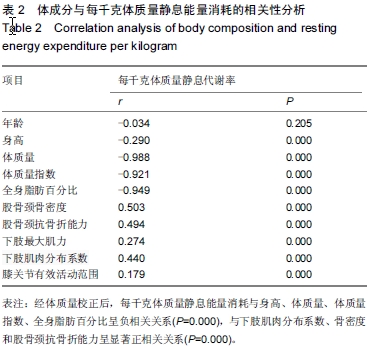| [1] WHO.九十年代绝经研究[M].刘云嵘译,葛秦生审校.北京:人民卫生出版社, 1998:11-12.
[2] 曹泽毅.中华妇产科学[M].2版.2006:2530-2582.
[3] 阮祥燕,Mueck,A.O.更年期相关症状及疾病防治理论与实践[M].北京:人民卫生出版社,2013.
[4] 王珺,阮祥燕.女性静息能量消耗与肥胖相关因素[J]. 中国组织工程研究与临床康复,2009,13(28):5585-5588.
[5] Mcardle WD, Katch FI, Katch VL. Exercise Physiology-Energy, nutrition and human performance. Philadelphia: LEA&FEBIGER.1981;105-117.
[6] Jia WP, Yang M, Shao XY, et al.Resting energy expenditure and its relationship with patterns of obesity and visceral fat area in Chinese adults.Biomed Environ Sci.2005;18(2): 103-107.
[7] Rigaud D.Energy expenditure. How can they be measured?. Rev Prat. 2009;59(1):41-47.
[8] da Silva HG Mendonea LM,Conceiglto FL,et al. Infiuence of obesity on bone density in postmenopausal women. Arq Bras EndocrinoI MetaboI.2007;51(6):943-949.
[9] Rashid MN, Fuentes F, Touchon RC, et al. Obesity and the risk for cardiovascular disease. Prev Cardiol. 2003;6(1): 42-47.
[10] Kunz I, Schorr U, Klaus S, et al. Resting metabolic rate and substrate use in obesity hypertension. Hypertension. 2000; 36(1):26-32.
[11] Moran O, Phillip M.Leptin: obesity, diabetes and other peripheral effects--a review.Pediatr Diabetes. 2003;4(2): 101-9.
[12] Tufano A,Marzo P,Enrini R,et al. Anthropometric,hormonal and biochemical differences in Iean and obese women before and after menopause. J EndocrinoIlnvest. 2004;27:648-653.
[13] Poehlman ET,Toth MJ,Gardner AW. Changes in energy balance and body composition at menopause:a controlled longitudinal study. Ann Intern Med.1995;123(9):673-675.
[14] Melnnes K J, Corbould A,Simpson ER, et al. Regulation of adenosine 5'-monophosphate activated protein kinase and lipogenosis by androgens contributes to visceral obesity in an estrogen-deficient state. Endocrinology,2006;147(12): 5907-5913.
[15] 金婧,阮祥燕. 绝经妇女体成分与血脂相关关系的研究[J]. 中国骨质疏松杂志,2007,10:720-722.
[16] Pansini F,Cervellati C,Guariento A,et al. Oxidative slress,body fat composition,and endocrine status in pre-and postmenopausal women.Menopause.2008;15(1):112-118.
[17] Garnier S, Vallée K, Lemoine-Morel S,et al.Food group preferences and energy balance in moderately obese postmenopausal women subjected to brisk walking program. Appl Physiol Nutr Metab.2015;40(7):741-748.
[18] 林梅,凌文志,黄迎春,等.门诊不同年龄性别体检者人体成分调查分析医学研究生学报[J].2015,3:294-296
[19] Chen Y, Xiang J, Wang Z.Associations of Bone Mineral Density with Lean Mass, Fat Mass, and Dietary Patterns in Postmenopausal Chinese Women: A 2-Year Prospective Study.PLoSOne.2015Sep3;10(9):e0137097
[20] 黄喜顺,吴义森,兰宇频,等.三种不同时期妇女骨密度测量值研究分析[J].中国医学装备2015,12(1):60-61.
[21] Goran MI. Energy metabolism and obesity. Med Clin North Am.2000;84:347-362.
[22] Lane K, Martin AD, Gelmon KA, et al. Resting energy expenditure and body mass changes in women during asjuvant chemotherapy for breast cancer. Cancer Nurs. 2007; 30(2):95-100.
[23] 宗敏,孙建琴,张鑫毅,等.中老年糖尿病患者静息能量消耗[J].重庆医学,2012,41(10):3087
[24] Day DS, Gozansky WS, Van Pelt RE, et al.Sex hormone suppression reduces resting energy expenditure and {beta}-adrenergic support of resting energy expenditure.J Clin Endocrinol Metab.2005;90(6):3312-3317.
[25] 柴晟.探讨运动对静息代谢的影响[J].科教导刊:电子版. 2014, 9:116-117
[26] Aubertin-Leheudre M,Goulet ED,Dionne IJ.Enhanced rate of resting energy Expenditure in women using hormone- replacement therapy:preliminary results. Aging Phys Act.2008; 16(1):53-60.
[27] 杨明,贾伟平,包玉倩,等.性别、年龄及体脂参数与静息能量消耗的关系[J].中华内分泌代谢杂志,2004,1:20-22.
[28] 顾新,李京平,陈刚,等.对肥胖者静息代谢率的研究[J].中国康复医学杂志,2005,20(3):200-202.
[29] Mangweth-Matzek B1, Hoek HW, Rupp CI,The menopausal transition--a possible window of vulnerability for eating pathology. Int J Eat Disord.2013;46(6):609-616.
[30] 梁成军.抗阻力训练的减肥效果[J].湖北体育科技,2014,33(7): 603-605. |


